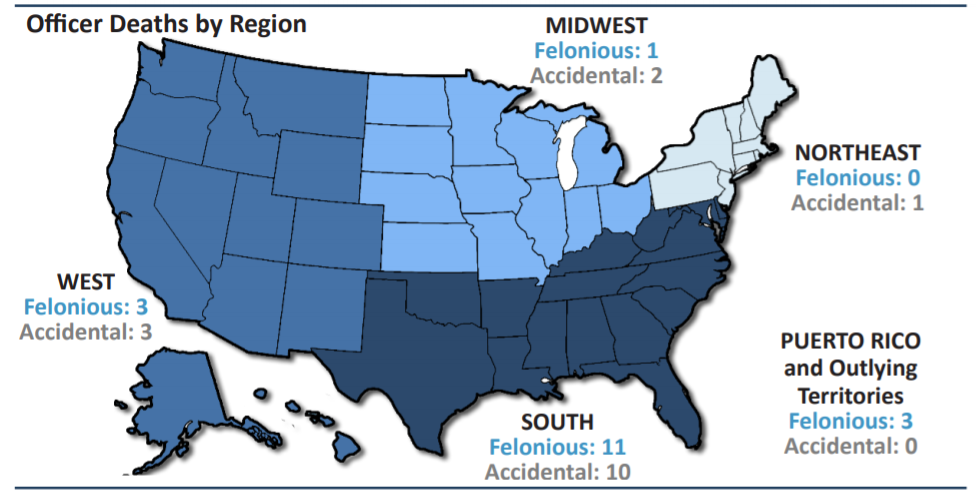Felonious Acts Led To The Death Of 46 LEOs In 2020, Shows FBI Data
By a Biometrica staffer

In March, just a day after a 21-year-old shooter opened fire at a supermarket in Boulder, Colorado, killing 10 people including a police officer, we examined the felony killings of American law enforcement officers (LEO) in 2019. Today, we take a look at the numbers for 2020.
By any yardstick, when you factor in the rate of assault and injury on duty, being in law enforcement gets catapulted to the top of any “most dangerous jobs in America” list. While being a law enforcement officer may not necessarily be the most “dangerous job in America” in terms of numbers, it is probably the only legal peacetime job out there where you wake up and leave for work every morning, knowing someone may intentionally try and kill you that day. And the next. And every single day thereafter. Day in, day out. Week in, week out, year in, year out. Or at least, someone may try their best to do so.
On May 3, the Federal Bureau of Investigation (FBI) released statistics on Law Enforcement Officers Killed in the Line of Duty for 2020. Its more comprehensive report on assault data, which is on the number of LEOs assaulted while performing their duty — typically, an exponentially higher number than those killed — is scheduled to be released in the fall.
In total, 93 LEOs were reported to have been killed in line-of-duty incidents in 2020. Of those, 46 officers lost their lives due to felonious acts while 47 died in accidents. The 46 felony killings of LEOs in 2020 compares with 48 in 2019, and 55 in 2018. The 5- and 10-year comparisons show a decrease of 20 felonious deaths compared with the 2016 figure (66 officers), and a decrease of 26 deaths compared with 2011 (72 officers).
But in 2019, firearms were used in the felony killings of only 29 of the 48 victim officers’s deaths. Whereas, in 2020, offenders used firearms to kill 41 out of the 46 victim officers. Of those, 21 were slain with handguns, 10 with rifles and in the remaining 10 instances, the type of firearm was either unknown or not reported.
Of the five remaining victim officers in 2020 (out of 46): four were killed with vehicles used as weapons, while one was killed by the offender’s use of personal weapons (hand, fists, feet, etc.).
In 2020, the 46 felony killings took place in 25 states. While felonious deaths were reported across all four U.S. regions, the south saw the highest with 24 reported deaths, followed by the Midwest with 11, the West with 10, and finally one in the Northeast.
The average age of the officers who were feloniously killed was 39 years old. The victim officers had served in law enforcement for an average of 12 years. In terms of profiles of the officers feloniously killed:
• 41 were male
• 5 were female
• 32 were White
• 10 were Black/African American
• 2 were Native Hawaiian/Other Pacific Islander
• 1 was American Indian/Alaska Native
• The race of 1 officer who died was not reported
The following are the circumstances encountered by the victim officers when they arrived at the scenes of the incidents:
• 9 were ambushed (entrapment/premeditation)
• 7 died as a result of investigative or law enforcement activities
• 7 were assisting other law enforcement officers
• 5 were responding to crimes in progress
• 4 were responding to disorders or disturbances
• 3 were involved in arrest situations
• 2 were responding to citizen complaints
• 2 were involved in tactical situations serving/attempting to serve an arrest warrant
• 2 had encountered or were assisting a person experiencing an emotional disturbance
• 2 were killed during an unprovoked attack
• 1 was serving/attempting to serve court order (eviction notice, subpoena, etc.)
• 1 was assisting a motorist
• 1 was killed in an incident reported in the category of “other”
In terms of the offenders who killed the victim officers, 20 had prior criminal arrests, and five were under judicial supervision at the times of the incidents.
Accidental deaths of LEOs in 2020 (of 47 officers) increased by 6 when compared with data for 2019. A majority of the 47 deaths happened due to motor vehicle crashes. The average age of officers who were accidentally killed was 40, while the average number of years the victim officers had served in law enforcement was 10.